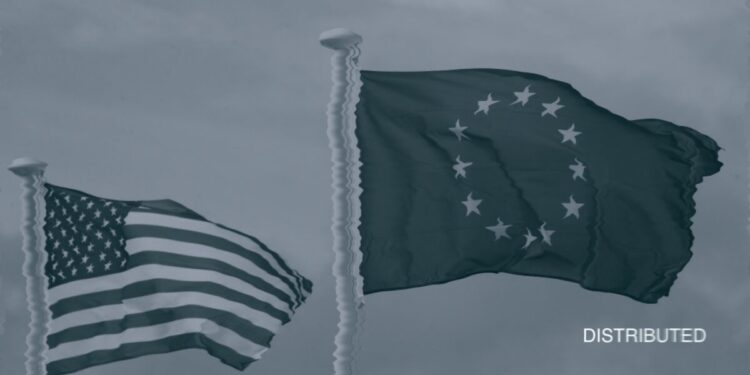European banks are facing a turbulent ride as financial markets react strongly to the latest political shockwaves coming from the United States. On Friday, European banking stocks took another sharp hit, deepening the selloff that began a day earlier. This decline was triggered by sweeping tariffs announced by U.S. President Donald Trump, sending global equities into a downward spiral and leaving financial institutions particularly vulnerable.
The sector-wide slump has been stark. A broad index tracking European banks dropped 3.3% on Friday morning, marking its lowest point since early February. This came on the heels of a 5.5% decline on Thursday, bringing the total loss over just two trading sessions to a staggering 8.5%. That’s the steepest two-day fall the index has seen in three years. Major banks such as Italy’s BPER Banca, Germany’s Deutsche Bank, and Spain’s Sabadell were among the hardest hit, each shedding roughly 4.3% in share value.
See Related: FTX Settles European Expansion Dispute For $33M
Banking Stocks And The Economy
But the selloff isn’t just confined to Europe. Banking stocks around the world are suffering. In the United States, giants like Goldman Sachs, Morgan Stanley, and JPMorgan saw their shares plummet by 7% to 9% overnight. These are some of the largest single-day declines since the economic uncertainty of 2020, showing just how deeply investor sentiment has been rattled. In Asia, the trend continued as Japan’s financial stock index nosedived by as much as 11% at one point on Friday.
The sudden and sharp drop in banking shares reflects a broader market fear: uncertainty about the future of global trade. Tariffs not only impact goods and services but also shake investor confidence. When trade tensions escalate, businesses worry about supply chains, profit margins shrink, and consumers feel the pinch. Banks, which sit at the center of the economic web, are often the first to feel the pressure when confidence dips.
This selloff also raises questions about the fragility of the financial system. While banks today are stronger than they were during the 2008 financial crisis, they are still vulnerable to external shocks like trade wars, interest rate hikes, and geopolitical instability. The fact that such a large portion of the global banking sector can lose significant value in just two days speaks volumes about how interconnected and sensitive modern markets are.
The outlook remains uncertain. If trade tensions between the U.S. and its global partners continue to escalate, we could see a prolonged period of volatility. Banks might face tighter margins, reduced lending activity, and lower consumer confidence. In a worst-case scenario, this could ripple out to other sectors, triggering a broader economic slowdown.
Monetary Policies And Central Banks
However, there is also a possibility that this turmoil could push central banks to take action. We might see more accommodative monetary policies, stimulus measures, or even intervention to stabilize markets. Additionally, countries could move to strengthen trade alliances outside of U.S. influence, reshaping global economic relationships in the long run.
The next few months will be critical. Investors, policymakers, and everyday consumers alike will be watching closely. For now, though, the message is clear: global markets are deeply interconnected, and actions taken in one part of the world, especially by major powers like the U.S., can send shockwaves across continents. As European banks lick their wounds from this week’s dramatic downturn, the world braces for what might come next.



